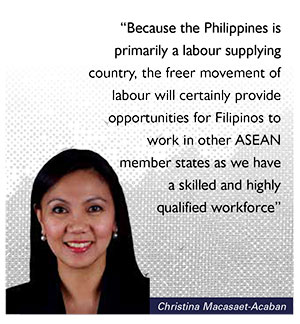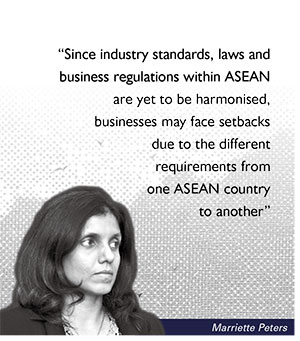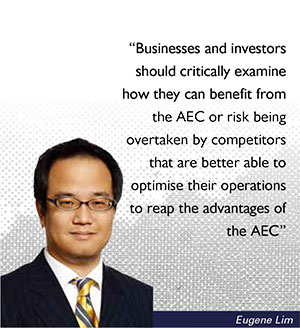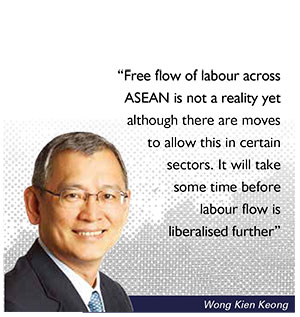By Chris Thomson
Want to know if the ASEAN Economic Community is Asia, and perhaps the world’s, next big thing? With its diverse markets and political systems, there’s debate over whether the region’s 10 jurisdictions can work as one and if so, how long it will take for them to integrate, their goal being to do so by the end of 2015. Given the well-documented slow-down in Asia’s emerging markets, can the ASEAN economic integration be a successful one and make the region competitive and worthy of investment?
ASEAN, or the Association of Southeast Asian Nations, was established in 1967, and initially brought together Indonesia, Malaysia, the Philippines, Singapore and Thailand. Subsequently, Brunei, joined in 1984, Vietnam in 1955 and Laos and Myanmar in 1997. By the end of 2015, all 10 nations have the goal of forging the ASEAN economic community, envisaging a single market and production base, a highly competitive economic region, a region of equitable economic development and a region fully integrated into the global economy.
The ASEAN Economic Community (AEC), due to be put in place later this year, is sure to shake things up, but how and when this shaking will occur is still up for debate. As with any integration, be it an M&A between companies or an integration between a total of 10 jurisdictions, this is sure to have teething problems, but whether fortune will favour the brave investor in this instance or the 10 nations are simply too incompatible won’t be known for sure until long after the birth of the AEC.
According to Mergermarket, “M&A activity targeting Southeast Asia in Q1 2015 was almost on par with Q1 2014 in terms of deal value, with a total of 81 deals worth US$10.5 billion announced in the quarter, representing a mere 2.2 percent drop in value since Q1 2014”. Their trend report also noted that “Singapore continued to be the most targeted within Southeast Asia, with 24 deals worth US$4.8 billion” in 2015, and that the real estate sector continued to be the highe st performing sector in ASEAN in Q1 2015, boasting 30.9 percent of the market share.
Stating his optimism about the integration, Richard Dailly, Managing Director at Kroll, said “Free flows of services and investments should benefit all intra-AEC business”. Dailly also said he sees Singapore, Malaysia, Thailand and the Philippines the most likely of the nations to immediately prosper, due to their established professional service firms. On sectors, he claimed that “Movement of skilled labour will benefit the growing healthcare and technology sectors across the region”.
Giving his thoughts, Dr Wong Kien Keong, chairman of Baker & McKenzie’s member firms in Singapore, Indonesia and Malaysia said he foresees the capital growth rate in ASEAN between now and 2020 being “the third fastest in the world after China and India”. He went on to say that “In addition, Singapore, being a capital or money centre, will help attract the flow of capital into ASEAN from the rest of the world, particularly from China, India, Japan, the US and Europe.”
“In relation to expropriation and other concerns of investors”, Wong went on to say, “The ASEAN countries have entered into the ASEAN Comprehensive Investment Agreement (ACIA) to continue liberalisation, protection of investments from member states, and increasing the transparency and predictability relating to rules, regulations and procedures governing investments in the member states, among other objectives.”
On objectives, Dailly noted that “One of the main drivers of the AEC project is to aid the equitable economic development of the smaller, less developed markets in Southeast Asia. ASEAN has stated that its priority aims are to improve infrastructure development, education, and information and communication technologies.”
 ASEAN’s nations One of the economies of ASEAN that will be hoping to see development is Myanmar, where “The legal infrastructure is being overhauled and modernised as part of the reform process and opening up to the outside world”, according to Josephine Price, Managing Director and co-founder of Anthem Asia, an independent investment and advisory group focussing on building sustainable businesses in Myanmar. On top of this, as Price stated, “The country is part way through a huge series of reforms covering politics, civil society and the economy and business”. Though these reforms are still ongoing, Price believes “Myanmar is now clearly on its way to creating an environment that should work for ASEAN investors”. Also giving insight into Myanmar was DFDL’s William Greenlee, according to whom “Mynamar will benefit from the integration as there will be more foreign investment and international involvement in the community. From this increase in international involvement, Myanmar will be able to more quickly implement positive aspects of world commerce and its accompanying infrastructure systems, including legal systems that encourage commerce.” Another jurisdiction that will expect to see its economy grow as a result of the ASEAN integration is the Philippines, which, according to Christina Macasaet-Acaban, partner at Quisumbing Torres “provides the country with the impetus to examine the competitiveness of its businesses and legal and regulatory environment, and to make changes in these areas in order to maximise the benefits arising from the integration”. She did, however, say that “Because the Philippines is primarily a labour supplying country, the freer movement of labour will certainly provide opportunities for Filipinos to work in other ASEAN member states as [it has] a skilled and highly qualified workforce”. Macasaet-Acaban countered this, though, with the fact that “If the integration will result in more inbound investment in the Philippines and an increase and growth in businesses within the country, this will make the Philippines competitive in retaining its talent and workforce in the country”. |
 Should Macasaet-Acaban be proven right in her assessment that the Filipino workforce will be tempted to work elsewhere even more than it already is, by Greenlee’s judgement, a lot of the migration will be to Myanmar, as he believes that “For skilled labour it will likely mean an increase in incoming labour [to Myanmar], which at this early stage in opening up to the world will alleviate current shortages”. He did also mention that he feels there will be an increase in Myanmar’s outgoing citizens as its residents seek manual labour positions elsewhere within ASEAN. Discussing labour, Marriette Peters, partner at Zul Rafique noted that “Companies will find it easier to recruit, retain and manage their workforce on a regional basis. This is, however, subject to the Mutual Recognition Arrangement (MRA), which differs from one country to another with regard to recognised education and experience, licenses and certificates which have been granted by another country.” One of SSEK’s founding Partners, Ira Eddymurthy, also mentioned the MRA: “Skilled workers will likely gravitate toward states that are centres for their occupation, where their expertise will be highly valued. However, it is unlikely that states, including Indonesia, will be quick to ease restrictions on expatriate workers, noting the reservations toward employment matters in the ratification of the ACIA and the extent of states’ commitments in the ASEAN Framework Agreement on Services.” Giving comparisons, Sesto E. Vecchi, a founding Partner of Russin & Vecchi pointed out that “Among the larger Asian countries – Thailand, Indonesia, Malaysia and the Philippines – Vietnam’s legal system is probably the least well developed. Yet, in many areas, Vietnam competes commercially with all of those countries.” On some of the smaller economies of the 10 jurisdictions, Dailly said that “Cambodia and Laos will benefit from having inexpensive labour, and they are already starting from a lower point in the development curve. In many respects, Cambodia, Myanmar and Laos could ultimately be the most significant winners – certainly in economic terms. Investment is already hot into both Cambodia and Laos, and Myanmar is frequently referred to as ‘the next tiger’. However, these countries need to improve their regulatory environments.” For Singapore, as the nation with the highest GDP per capita in ASEAN, there will of course, be different implications. According to Eugene Lim, Head of Baker & McKenzie’s Asia Pacific Trade & Commerce Practice, “There will be a greater need for regional headquarters as regional integration removes trade and investment barriers and increases business activities in ASEAN [and] Singapore can be used by non-ASEAN-based companies as a stepping stone to gain preferential access into Southeast Asian markets”. This, Lim feels, will mean that “Singapore will benefit as a result of the greater interest and levels of investments in ASEAN arising from greater integration”. Thailand too has reason for optimism, with “a marked increase in domestic deal activity within Southeast Asia, with 11 deals valued at US$2.3 billion recorded in Q1 2015, increasing 10 fold since Q1 2014” according to Mergermarket, who predict their economy will continue to grow. |
 What kind of integration will it be? As stated by Eddymurthy, “It is of paramount importance to note that ASEAN economic integration is not a European Union model and does not create a supranational body. It is a gradual integrationin which ASEAN member countries agree on certain objectives to be attained and frameworks to implement such objectives, but the countries are given wide discretion to translate that into national policy.” On the comparison between the AEC and the EU, Dailly mentioned that “As with the EU, the fundamental problem that the AEC will have to deal with is the inherent tension between the existing nation-state as the key defining unit of territory”. He also noted that the EU has had a lot longer to get used to various historic iterations, and that as a result, “it could take many years for the full potential of the AEC to be unleashed. Border disputes between AEC nations will still be a challenge, and as we have seen from the recent refugee crisis, ethnicity, religion and sovereignty of national borders are still political ‘hot potatoes’. But for the AEC to work, national governments will need to grip these issues and work together closely to find solutions.” Macasaet-Acaban too felt it necessary to distinguish ASEAN from the EU, noting “The concept of ASEAN integration does not envision an integration that is similar to the European Union. Notwithstanding the alignment and harmonisation of laws and regulations, each ASEAN member state continues to govern independently, make its own laws and regulations and enforce the same. “This means that an investor intending to engage in business in an ASEAN state must also study the country specific requirements that continue to exist, despite the alignment and harmonisation of certain laws and regulations in the priority sectors.” |
 On the extent of the integration, Wong commented “Most jurisdictions will keep a certain aspect of their laws to maintain national imperatives in commercial life. However, the draw of harmonisation to attract investments in the different industries where individual nations may have strengths will continue to govern the integration of ASEAN. There will inevitably be some convergence of their laws such that similarities of some aspects of their respective commercial laws will arise. It would not be a question of sacrificing individuality, rather a question of balancing the two objectives, and this balance will not be detrimental as scales of the balance will change with time and evolution of society and laws.” On the effect uniformity will have on Malaysia and legal developments, Peters remarked “Having a single market will help reduce complexity as companies will be able to standardise products, services, business models and marketing plans. This in turn will encourage uniformity and, in the long run, benefit the business/marketing world in Malaysia since laws and regulations related thereto would be enacted and/or amended in order to better accommodate and match the demands of the ASEAN countries.” Fielding the question from a similar angle from a Singapore point of view, Lim stated “As laws become more uniform, the regulatory cost of doing business in ASEAN will be reduced. This will allow businesses to streamline their business operations by adopting increasingly similar business models when operating across multiple jurisdictions in the region.” Continuing, he said “Uniform laws will provide businesses with flexibility in structuring operations and not need to adopt specific work around to comply with local legal restrictions”. |
 Looking at the implications of uniformity on Myanmar, Greenlee observed “Laws in ASEAN becoming more uniform will have a significant impact on commerce in Myanmar and the region, as it will allow companies/investments to more easily cross borders into jurisdictions that currently have legal systems/laws that are restrictive, vague and/or generally onerous, which of course is currently a hurdle and hindrance to foreign investment”. Macasaet-Acaban said that overall, she expects the increased uniformity to have a positive effect on the Philippines. She also said “For the Philippines, challenges continue to exist and reforms must be instituted to hasten the country’s alignment with all the commitments and goals of the integration”. Giving further insight into the goals of the Philippines, Macasaet-Acaban noted “In achieving the goals of a freer flow of services and investment liberalisation, certain significant areas continue to be subject to foreign equity restrictions. These restrictions carry with them corresponding restrictions in participation of non-Filipinos in the management and operation of the restricted businesses. “As regards other sectors, the Philippines will need to continue to review and improve on processes in order to provide investors with greater ease in doing business in the country, both at the national and local government levels. For example, many investors have noted that the process to establish a business and incorporate an entity is significantly more complex and time-consuming in the Philippines compared to Singapore.” |

